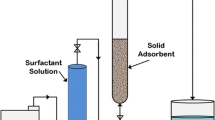Abstract
The stability of dye dispersions in the presence of ethoxylated sorbitan lauryl and oleyl esters were reported and compared with dye dispersions containing a conventional dispersing agent, i.e. naphthalene sulfonic acid methylene-bis sodium salt (NSAB). The optimum operating conditions obtained using a central composite design and stability of dye dispersions were evaluated by a turbidimetry method. Results showed that the dose of surfactants and the temperature of operation were important factors in preparing stable dye dispersions. Also, the best conditions for preparing dye dispersions were as follows: dose of surfactant 0.05 g, temperature 25 °C and time 5 min. In addition to, findings indicated that both of the used surfactants had better performance in dispersing the dyes in water. However, ethoxylated sorbitan oleate had better efficiency relative to other used dispersing agents. The performance of both sorbitan esters were compared with NSAB. The results indicated that they can create stable dye dispersions in aqueous media and have approximately the same effectiveness with NSAB. In this series, although oleate ester had a better performance than the laurate, the difference in performance of using dispersing agents was not significant. This finding was confirmed by the results of the particle size analysis of dye dispersions.




Similar content being viewed by others
References
Duff DG, Sinclair RS (1989) Giles laboratory course in dyeing. Society of Dyers and Colorist, Bradford
Metwally MA, Bondock S, El-Desouky SI, Abdou MM (2012) Synthesis, structure investigation and dyeing assessment of novel bisazo disperse dyes derived from 3-(2′-hydroxyphenyl)-1-phenyl-2-pyrazolin-5-ones. J Korean Chem Soc 56:348–356
Burkinshow SM (1995) Chemical principles of synthetic fiber dyeing. Blackie, Glasgow
Gharanjig K, Sadr Dadras F, Sadeghi-Kiakhani M, Khosravi A, Tafaghodi S (2013) Dispersibility of a monoazo disperse dye in the presence of various dispersing agents. J Dispersion Sci Technol 34:381–388
Gharanjig K, Sadeghi-Kiakhani M, Tehrani-Bagha AR, Khosravi A, Menger FM (2011) Solubility of two disperse dyes derived from N-alkyl and N-carboxylic acid naphthalimides in the presence of gemini cationic surfactants. J Surf Deterg 14:381–389
Nunn DM (1979) The dyeing of synthetic-polymer and acetate fibres. The Dyers Company Publications Trust, Bradford
Hunger K (2003) Industrial dyes chemistry, properties, applications. Wiley-VCH Verlag GmbH & Co. KGaA, Weinheim
Heimami S (1981) Textile auxiliaries: dispersing agents. Rev Prog Color 11:1–8
Merrettig-Bruns U, Jelen E (2009) Anaerobic biodegradation detergent surfactants. Materials 2:181–206
Pacwa-Płociniczak M, Płaza GA, Piotrowska-Sege Z, Cameotra SS (2011) Environmental applications of biosurfactants: recent advances. Int J Mol Sci 12:633–654
Schramm LL, Stasiuk EN, Marangoni DG (2003) Surfactants and their applications. Ann Rep Prog Chem Sect C 99:3–48
Simoes SI, Tapadas JM, Marques CM, Cruz MEM, Martin MBF, Cevc G (2005) Permeabilisation and solubilisation of soybean phosphatidylcholine bilayer vesicles as membrane models by polysorbate, Tween 80. Eur J Pharm Sci 26:307–317
Borrego E, Sicilia D, Rubio S, Perez-Bendito D (1999) Determination of polysorbates in foods by formation of mixed micelles. Anal Chim Acta 384:175–183
Pourrez N, Rastegarzadeh S (2004) Kinetic spectrophotometric determination of Tween 80. Talanta 62:87–90
Budavari S (1989) The Merck Index, 11th edn. Merck & Co, Rahway
Kang SW, Kim YB, Shin JD, Kim EK (2010) Enhanced biodegradation of hydrocarbons in soil by microbial biosurfactant, sophorolipid. Appl Biochem Biotechnol 160:780–790
Varma RK, Kaushal R, Junnarkar AY, Thomas GP, Naidu MU, Singh PP, Tripathi RM, Shridhar DR (1985) Polysorbate 80: a pharmacological study. Arzneimittelforschung 35:804–808
Gardiner WP, Gettinby G (1998) Experimental design techniques in statistical practice. Horwood, Chichester
Schmitz R, Odenthal DE (1983) Process for the preparation of quinizarin, U.S.Patent 4,387,054
Gharanjig K, Arami M, Dadras FS, Akbarzadeh A, Khosrav A (2005) Synthesis and investigation of dyeing properties of disperse red 73 for polyester fibers. In: 4th International Conference on Polymer Science and Technology ISPST, Tehran, Iran
Shore J (2002) Colorants and auxiliaries, vol 2. Society of Dyers and Colourists, Manchester
Patist A, Bhagwat SS, Penfield KW, Aikens P, Shah DO (2000) On the measurement of critical micelle concentrations of pure and technical-grade nonionic surfactants. J Surf Deterg 3:53–58
Schramm LL (1992) Emulsions, fundamentals and applications in the petroleum industry. American Chemical Society, Washington, DC
Schramm LL (1994) Foams, fundamentals and applications in the petroleum industry. American Chemical Society, Washington, DC
Hiemenz PC, Rajagopalan R (1997) Principles of colloid and surface chemistry. Dekker, New York
Triplett MD, Rathman JF (2009) Optimization of β-carotene loaded solid lipid nanoparticles preparation using a high shear homogenization technique. J Nanoparticle Res 11:601–614
Gharanjig K, Khosravi A, Niknam V, Ahmadi A, Hosseinnejad M (2011) Investigation of dissolution and dyeing properties of a disperse dye in the presence of Tween environmentally friendly dispersing agents. J Color Sci Technol 6:253–261
Author information
Authors and Affiliations
Corresponding author
About this article
Cite this article
Gharanjig, H., Gharanjig, K. & Tafaghodi, S. Stability of Dye Dispersions in the Presence of Some Eco-Friendly Dispersing Agents. J Surfact Deterg 16, 849–856 (2013). https://doi.org/10.1007/s11743-013-1493-x
Received:
Accepted:
Published:
Issue Date:
DOI: https://doi.org/10.1007/s11743-013-1493-x




